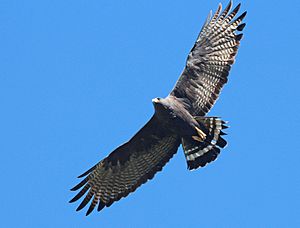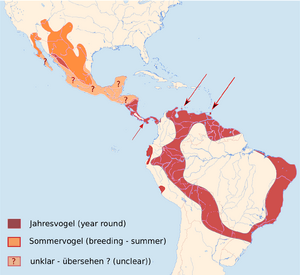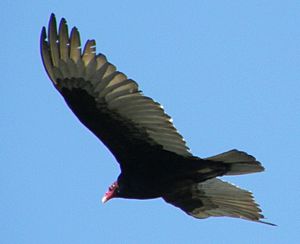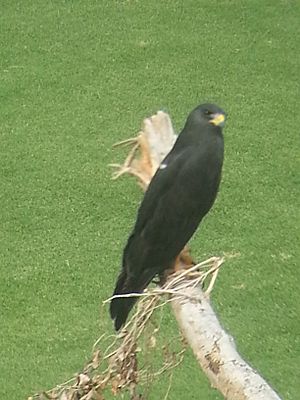Zone-tailed hawk facts for kids
Quick facts for kids Zone-tailed hawk |
|
|---|---|
 |
|
| Conservation status | |
| Scientific classification | |
| Genus: |
Buteo
|
| Species: |
albonotatus
|
 |
|
The zone-tailed hawk (Buteo albonotatus) is a medium-sized hawk that lives in warm, dry areas of the Americas. This bird looks and flies a bit like a turkey vulture. This similarity might help it blend in with groups of vultures. Zone-tailed hawks hunt and eat small animals that live on the ground.
Contents
About the Zone-tailed Hawk's Name
Scientists give every animal a special two-part name. This helps everyone know exactly which animal they are talking about. The zone-tailed hawk's scientific name is Buteo albonotatus.
A German naturalist named Johann Jakob Kaup officially described this hawk in 1847. He used the name Buteo albonotatus. The name albonotatus comes from Latin words. Albus means "white" and notatus means "marked". So, its name means "white-marked hawk". There are no different types or subspecies of this hawk.
What Does a Zone-tailed Hawk Look Like?
The zone-tailed hawk is a fairly large but slim hawk. Adult birds are about 46 to 56 centimeters (18 to 22 inches) long. Their wings can spread out about 117 to 140 centimeters (46 to 55 inches) wide.
Even though they are long, they can weigh less than some other large hawks. They usually weigh between 565 and 1080 grams (1.2 to 2.4 pounds). Female hawks are usually heavier than males. A female might weigh around 900 grams (2 pounds), while a male averages 637 grams (1.4 pounds).
Most of an adult hawk's feathers are blackish. But their flight feathers have lighter gray bars. These can look solid silver-gray when seen from far away. The tail has three or four bands, which are the "zones" in its name. These bands are white from below and light gray from above. The band second from the tip is usually the widest and easiest to see.
The hawk's beak area (called the cere) and legs are yellow. Its face has a light gray area and sometimes a bit of white. Young hawks look similar to adults. They have small white spots on their chest. Their tails have narrow gray and black bands with a wide dark tip.
Zone-tailed hawks look a bit like common black hawks. However, zone-tails are slimmer when they fly. They also have more white bars on their tail. Other dark-colored hawks might look similar. But they often have more silver on their wings and wider wings.
The call of the zone-tailed hawk is a loud scream. It sounds like a typical hawk call, dropping in pitch at the end. It might sound like kra kree-kree-kree-kree. They often make these calls when they are showing off during mating season. If something bothers them near their nest, they might make a long, low-pitched raaaaauu sound.
Where Do Zone-tailed Hawks Live?
Zone-tailed hawks live in many places. Their range stretches from parts of southern Arizona, New Mexico, and western Texas. They are found almost all over Mexico and central Central America. They also live in eastern Colombia, Ecuador, and sometimes in Peru, southern Brazil, Paraguay, Bolivia, and northern Argentina.
During winter, the hawks from the United States and northern Mexico usually move south. They spend winter mostly in Oaxaca and the Yucatán Peninsula. Hawks in Central America might also move around seasonally.
These hawks can live in many different types of places. They can be found in both open and closed areas, and in wet or dry spots. They are often seen in rocky areas where there is water nearby. They like forests with pine trees or oak trees. They also live in wooded canyons, along rivers, in dry bushy areas, and even in humid forests or overgrown marshes. They might hunt over farms or semi-desert areas. But they always need some trees for nesting. They can live from sea level up to 3,000 meters (9,800 feet) high. However, they are mostly found below 1,500 meters (4,900 feet) in the north. In the south, they are usually below 500 meters (1,600 feet).
How Zone-tailed Hawks Behave

The zone-tailed hawk's flight feathers look a lot like those of a turkey vulture. Zone-tailed hawks fly with their wings held in a V-shape, rocking from side to side. This is very similar to how turkey vultures fly. Bird experts warn people not to confuse them with the much more common turkey vulture.
However, from a reasonable distance, you can tell them apart. Zone-tailed hawks are smaller. They also have the typical hawk shape for their wings and head. Plus, they have a pale stripe on their tail. Turkey vultures often fly in groups called "kettles." Zone-tailed hawks can mix in with these groups. This might make them harder for people to spot.
Reproduction and Life Cycle
The mating season for zone-tailed hawks changes depending on where they live. But it usually happens in the first half of the year. In the northern parts of their range, breeding is from mid-April to July. In places like Trinidad and Ecuador, it's from February to June.
A male and female hawk will perform a courtship display. This can include flying loops, dives, and rolls together in the air. Their nest is a large, messy pile of sticks. It's lined with green leaves. They usually build it high up in a tree, about 7.5 to 30 meters (25 to 98 feet) off the ground. They often choose tall trees like cottonwoods or pines. The nest might be out in the open or hidden by leaves. Sometimes, they even build nests on cliffs.
The female usually lays one to three eggs, but most often two. The eggs are white and sometimes have brown marks. The eggs hatch after about 28 to 35 days. The female usually sits on the eggs to keep them warm. The male brings her food. Sometimes, the male might also sit on the eggs.
When the chicks hatch, they are covered in gray fuzz. They grow slowly for the first week. Then they grow much faster from 7 to 21 days old. In birds of prey, the older chick sometimes gets more food than the younger one. This means the older chick is more likely to survive. The younger chick is sometimes called the "spare" one. It might get more attention if the first one doesn't make it.
The young hawks learn to fly when they are 42 to 50 days old. But they aren't very good at flying until about a week later. They might stay with their parents until the next breeding season. However, if they live in areas where they migrate, the young and adults often separate.
Food and Hunting
Unlike turkey vultures, which mostly eat dead animals, zone-tailed hawks are active hunters. They hunt live prey. Some scientists think that looking like a turkey vulture helps the hawk. It might trick small animals into not being scared when a zone-tailed hawk flies overhead.
These hawks mainly hunt small birds and mammals, including bats. But they also really like to eat reptiles, especially lizards. In the northern areas, California quail and chipmunks seem to be their favorite foods. Zone-tails also eat young birds. They have been seen catching baby birds and young birds learning to fly. They snatch these young birds from trees or the ground without landing.
Zone-tailed hawks are very active hunters. They usually fly low, about 10 to 30 meters (33 to 98 feet) above the ground. They fly back and forth, searching for prey. When they spot an animal, they might use trees or other things to hide. This helps them get very close, usually within 0.5 to 2 meters (1.6 to 6.6 feet), before they strike. These hawks hunt alone. They are not known to hunt in pairs, except for the breeding pair bond.
See also
 In Spanish: Aguilucho negro para niños
In Spanish: Aguilucho negro para niños



